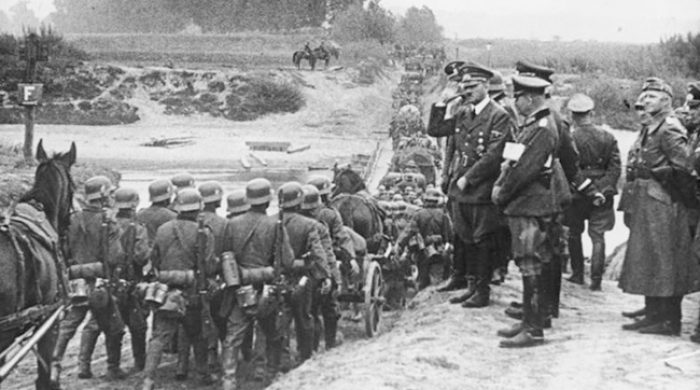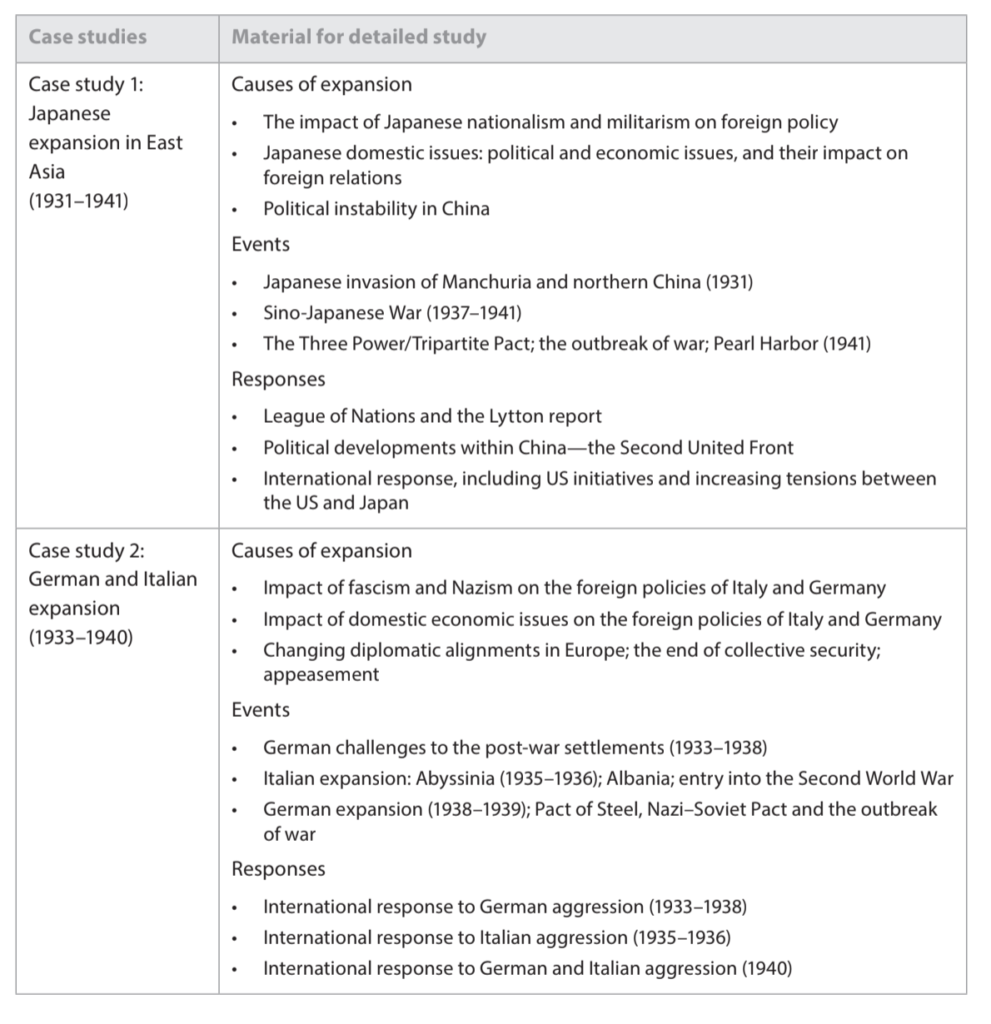
You will only be assessed on ONE of the case studies (question 9 is for the Move to Global War). For each, there will be four sources. There is usually at least one visual source but most are generally from historians.
How to answer Paper I questions
- Only attempt ONE case study for this paper. Some students panic and answer two!
- You MUST answer all four questions. The format of the questions is always the same so it is useful to learn them.
- The following is taken from the 2017 Specimen paper.
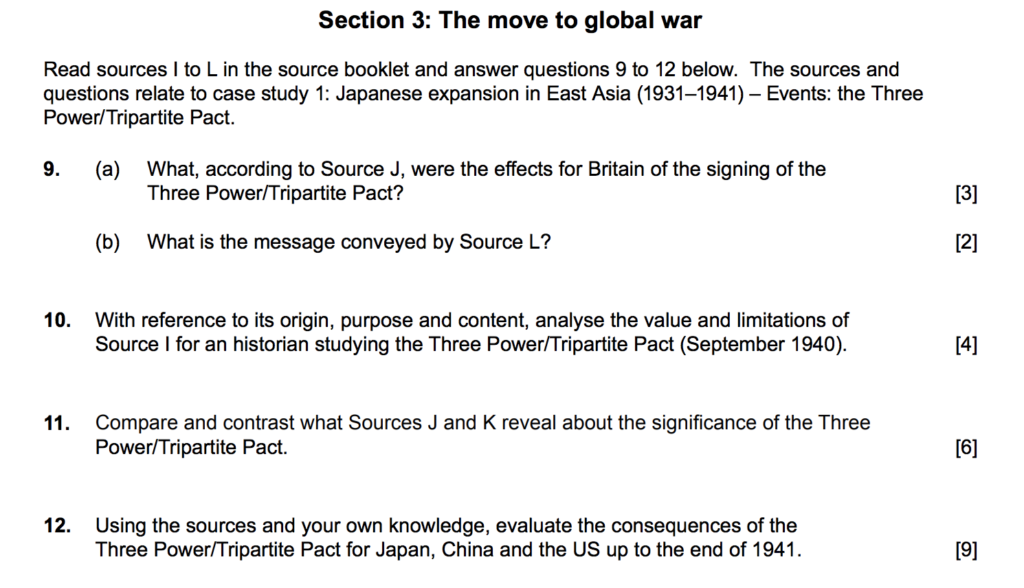
- TIME is one of the biggest issues facing all students. Ensure you develop a plan to answer all the questions in the time allotted. Two strategies are listed below.
- Remember that you have FIVE MINUTES reading time prior to starting the paper. Use this to read the first question and the relevant source. Under pressure, occasionally students make the error of analysing the wrong source. Therefore, use the five minutes to prevent this.
Strategy A
Q1a – 7.5 minutes
Q1b – 5 minutes
Q2 – 10 minutes
Q3 – 15 minutes
Q4 – 22.5 minutes
Total – 60 minutes.
Strategy B
Q1a – 6 minutes
Q1b – 4 minutes
Q2 – 8 minutes
Q3 – 12 minutes
Q4 – 18 minutes.
Total – 48 minutes, leaving 12 to plan and allow more time for the more difficult questions.
It is advisable to write the time you finish next to each question before you start the paper. For example, if you start at 1400, write 1406 next to question 1a.
Q1a (3 marks)
Make three points and support with evidence. Try to infer from the source too. Advice is to use firstly, secondly and thirdly. This question is worth three marks. You need to list three bullet points and briefly include the supporting evidence. Ensure your point is not the same language as the supporting evidence (which should be a direct quote but not a full sentence).
Q1b (2 marks)
Make two different points and support with evidence from the source. Use ‘one message is…because the source says that’ and the ‘second message is…because the source says that’.
Q2 (4 marks)
How does the origin, purpose and content of the source affect the value and limitations a historian puts on it? How useful is it? You can use contextual knowledge here.
When identifying the Origin, Purpose and Content of a source, ensure you link this to the reliability of it. Explain how it is a value or a limitation. Who is it valuable to and why/how? You could do this in two paragraphs, values and limitations.
Structure – Make sure you use the words Origin, Purpose, Content, Value and Limitation. This makes it obvious to the examiner!
The origin of source A is…From this we can deduce that its purpose which could be…
Therefore, the source is valuable because…For example, in terms of its content, it … (focus on facts provided and attitudes revealed)
Nevertheless, it also has some limitations in the sense that…For example, in terms of its content, it… (focus on factual omissions and unfair prejudices)
Q3 (6 marks)
Compare and contrast two sources. What is similar and what is different? Identify both. Use words such as whilst, however, whereas, similarly, yet et cetera. Quote the source but only briefly. It is important to link your analysis to the topic of the question, not just identify the similarities and differences.
Do:
- Use words such as: whereas, on the other hand, similarly, the sources agree/ disagree in/with…For example, Source K states that…whereas Source K disagrees and states that…
- Aim to make at least two similarities and differences.
- Make it explicit which source you are analysing, e.g. Japan’s intention to create a Greater East Asia Co-Prosperity Sphere (source K) differs from its announcements that it was acting to defend itself from the western imperialists (source M).
Do not:
- Explain or critically analyse one source by itself.
- Describe the sources
- Write an essay with an introduction and conclusion.
- Discuss why the source is similar or different. Focus on how.
- List the similarities and differences, avoid bullet points.
A simple structure is to write two paragraphs, one for similarities and one for differences. Aim for about three analytical points in each.
Q4 (9 marks)
This is a mini-essay. This is where you include both your knowledge and analyses of sources. Use all the sources, referring to them as ‘Source B states/ explains’ that…Ensure that they are used to support an argument or perspective you are developing. They should be embedded in the analysis and not appear as an add-on. Furthermore, it is useful to include the historiography or the controversy of the topic. This shows a higher level of understanding.
As with all essays, include,
- Introduction
- Thesis Statement
- Aim for five paragraphs.
- One or two paragraphs should focus on one interpretation of the answer. The other should focus on a different interpretation.
- And make sure your essay reaches a conclusion which answers the question. Try to identify the ONE source that answers the question more than the others. This demonstrates your understanding.
It is advisable to develop a brief essay outline before you begin. If you have time at the end of the examination, spend more on this question.
OPCVL
The following are taken from your ‘Move to Global War‘ textbook which we have in school.
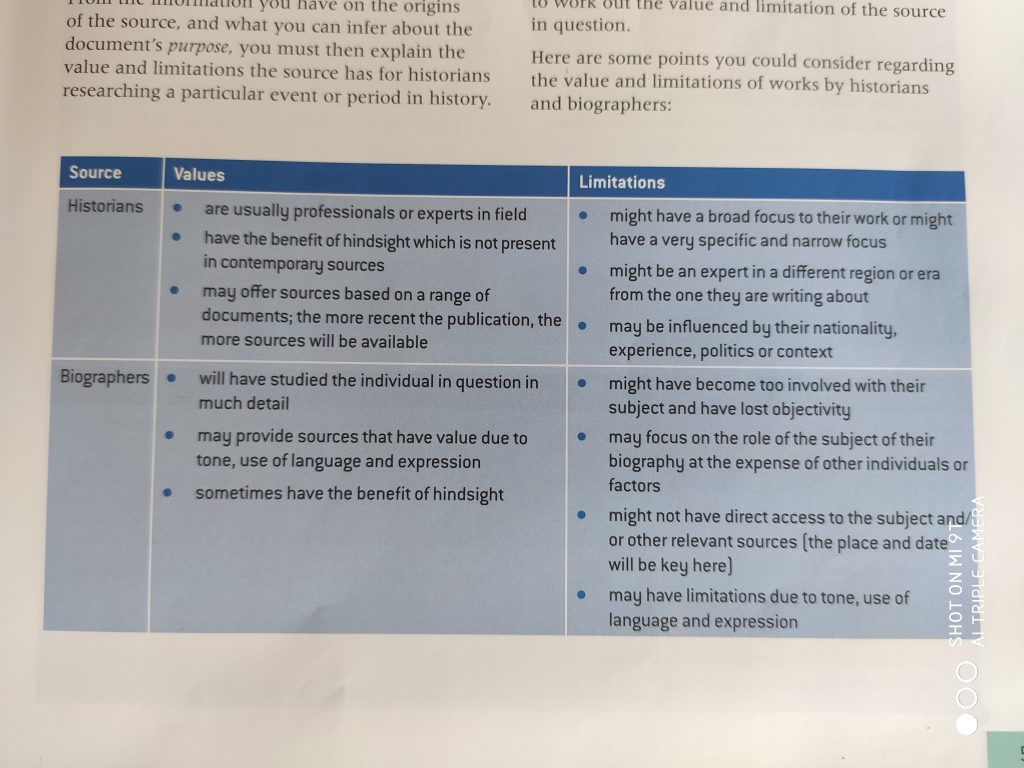
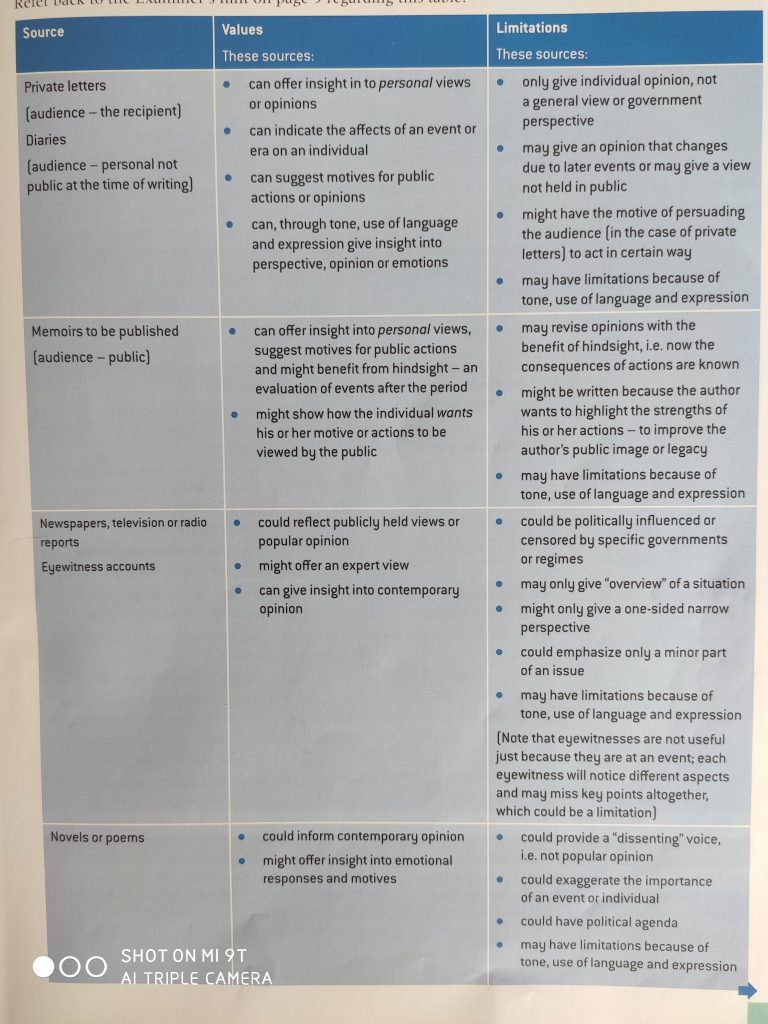
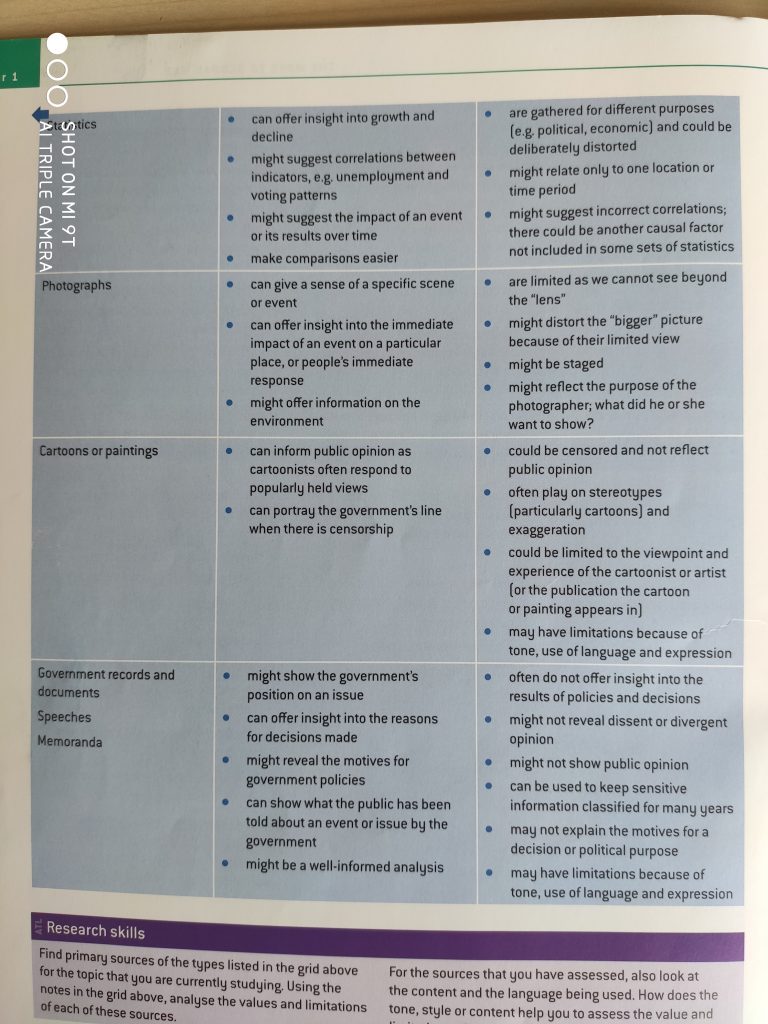
Paper One Rubric
Question 1 a – 3 points
Firstly,
Secondly,
Thirdly,
Question 1 b – 2 points
Point, Evidence, Explanation x 2
Question 2 – 4 points
Level 1 – An attempt has been made to analyze the value and/or limitations of the source, but conclusions are weak. Analysis of origin, purpose, and content is missing or incorrect.
Level 2 – Analysis of value is and/or only refers to one point of value. The analysis of the origin, purpose, and content is limited and/or missing some components. Analysis of limitations is inconsistent and/or only refers to one limitation. The analysis of the origin, purpose and content is limited and/or missing some components
Level 3 – Analysis of value is satisfactory and refers to at least two separate points of value. Each point includes an analysis of the origin, purpose and content of the source. Analysis of limitations is satisfactory and refers to at least two separate limitations. This includes an analysis of the origin, purpose and content of the source.
Level 4 – Analysis of value is in-depth and refers to multiple points. This includes a deep analysis of the significance of origin, purpose and content to both the overall and intrinsic value of the source. Analysis of limitations draws on external knowledge and refers to multiple limitations. This includes a deep analysis of the significance of origin, purpose and content for both the overall and intrinsic value of the source.
Question 3 6 marks
Level 1-2 – There is superficial discussion of one of both sources. The response consists of description of the content of the source(s), and/or general comments about the source(s), rather than valid points of comparison or of contrast.
Level 3-4 – There is some discussion of both sources, although the two sources may be discussed separately The response includes some valid points of comparison and/or contrast, although these points may lack clarity.
Level 5-6 – There is discussion of both sources. Explicit links are made between the two sources. The response includes clear and valid points of comparison and contrast.
Question 4 9 marks
Level 1-3 – The response lacks focus on the question. References to the sources are made, but at this level these references are likely to consist of descriptions of the content of the sources rather than the sources being used as evidence to support the analysis. No own knowledge is demonstrated, or where it is demonstrated, it is inaccurate or irrelevant.
Level 4-6 – The response is generally focused on the question. References are made to the sources, and these references are used as evidence to support the analysis. Where own knowledge is demonstrated, this lacks relevance or accuracy. There is little or no attempt to synthesize own knowledge and source material.
Level 7-9 – The response is focused on the question. Clear references are made to the source, and these references are used effectively as evidence to support the analysis. Accurate and relevant own knowledge is demonstrated. There is effective synthesis of own knowledge and source material.
May 2018 Grade Boundaries
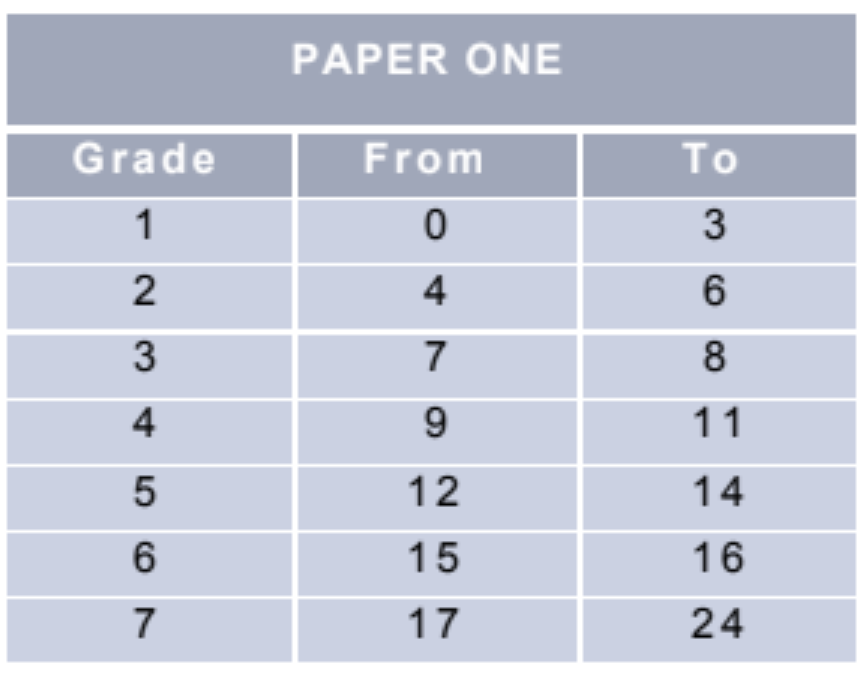
Previous Papers

